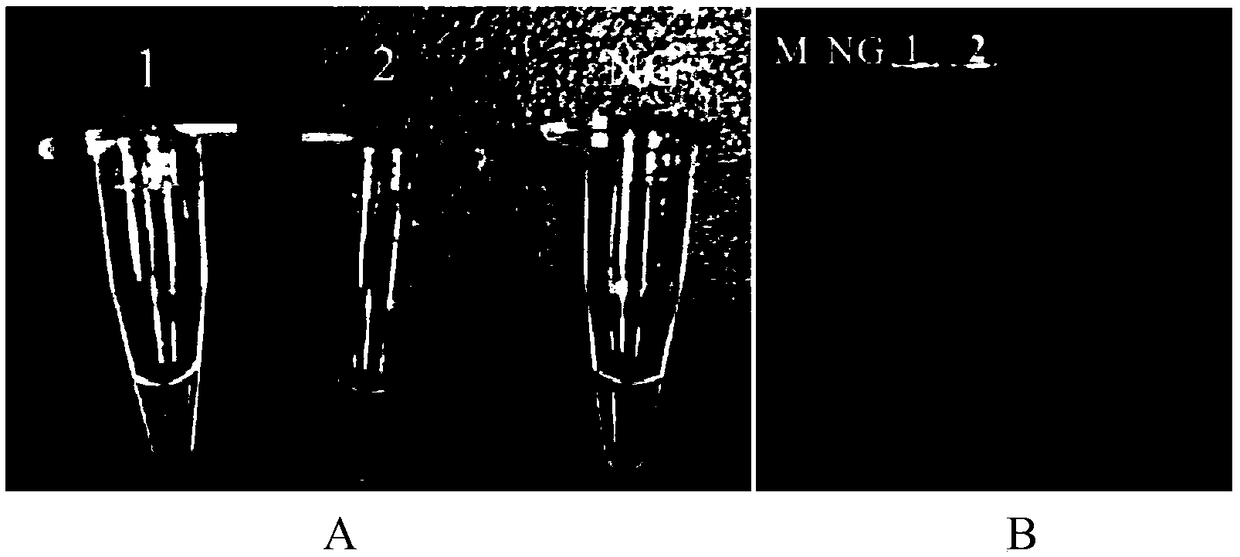Primer, kit and detection method for detecting salmonella at constant temperature on the basis of polymerase spiral reaction
A technology for detecting Salmonella and primers, applied in the biological field, can solve the problems of being unsuitable for rapid detection at the grassroots level, complex primer design, and high false positive rate, and achieve the effects of simple and fast operation, short time-consuming and good specificity
- Summary
- Abstract
- Description
- Claims
- Application Information
AI Technical Summary
Problems solved by technology
Method used
Image
Examples
Embodiment 1
[0038] Example 1 Microbiological method for detection of Salmonella based on polymerase helical reaction isothermal amplification technology
[0039] 1. A method for detecting pathogenic microorganisms based on polymerase helical isothermal amplification technology. In this embodiment, Salmonella is taken as an example. The reagents used are as follows:
[0040] a. Detection primers Ft aqueous solution and Bt aqueous solution, accelerated primer IF and IB aqueous solution with a concentration of 50 μM each, the primer sequences are as follows (5'-3'):
[0041] Detection primer Ft: cacaaagatgataatgatgccTACTGGAAAGGGAAAGCC (SEQ ID NO.1);
[0042] Detection primer Bt: ccgtagtaatagtagaaacacGACAGAGCGGAGGATAAA (SEQ ID NO.2);
[0043] Acceleration primer IF: TCATCGCACCGTCAAA (SEQ ID NO.3);
[0044] Acceleration primer IB: TGGCGGTATTTCGGTGGG (SEQ ID NO.4);
[0045] b.2×Reaction stock solution: Tris-HCl with a concentration of 40.0mM, ammonium sulfate 20.0mM, potassium chloride 20.0m...
Embodiment 2
[0054] The specificity test of embodiment 2 polymerase helical reaction detection Salmonella
[0055] The genomic DNA of Salmonella and non-Salmonella was established according to the above-mentioned reaction system and conditions to establish a polymerase helical reaction detection method for specificity tests, wherein the non-Salmonella were: Salmonella ATCC14028, Salmonella ATCC29629, Escherichia coli ATCC43895, Escherichia coli ATCC438944, Pseudomonas aeruginosa bacteria ATCC27853, Listeria monocytogenes ATCC19116, Listeria monocytogenes ATCC19114, Staphylococcus aureus ATCC27664, Lactobacillus casei GBHM-21 (Bao Zhining. Lactobacillus casei GBHM-21 identification, pilot plant preparation and fermentation technology research [D ]. South China University of Technology, 2015.). Set the Salmonella genome as a positive control, ultrapure water as a negative control, the results are as follows figure 2 shown. The results showed that only the Salmonella genome showed a positi...
Embodiment 3
[0056] Embodiment 3PSR detects the sensitivity test of Salmonella
[0057] The genome of Salmonella was diluted 10 times in a concentration gradient, respectively 12.3ng / μL, 1.23ng / μL, 123pg / μL, 12.3pg / μL and 1.23pg / μL, and a negative control (deionized water) was set at the same time, according to the example The reaction system in 1 is used to construct the polymerase helical reaction amplification method to determine the sensitivity of the detection method, the results are as follows image 3 shown. The results showed that the established Salmonella polymerase helical reaction method could detect 123pg / μl of Salmonella DNA in the sample.
[0058] Conclusion: From the above experimental results, it can be seen that the amplification method based on polymerase helical reaction has the following advantages over conventional PCR and fluorescent PCR:
[0059] The operation and identification are simple and quick: the whole process of conventional PCR can produce results in 2-4...
PUM
 Login to View More
Login to View More Abstract
Description
Claims
Application Information
 Login to View More
Login to View More - R&D
- Intellectual Property
- Life Sciences
- Materials
- Tech Scout
- Unparalleled Data Quality
- Higher Quality Content
- 60% Fewer Hallucinations
Browse by: Latest US Patents, China's latest patents, Technical Efficacy Thesaurus, Application Domain, Technology Topic, Popular Technical Reports.
© 2025 PatSnap. All rights reserved.Legal|Privacy policy|Modern Slavery Act Transparency Statement|Sitemap|About US| Contact US: help@patsnap.com



